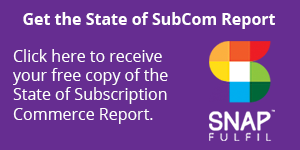SnapFulfil/SUBTA survey reveals subscription commerce strategies, challenges
With the growth of personalization in retail, it’s no surprise that subscription commerce is growing exponentially. There’s a monthly subscription box for almost any interest, from books to wine to pet products, and the number and quality of options is only going to increase.
To better understand what makes these subscription companies tick, we joined forces with the Subscription Trade Association (SUBTA) on the first-ever State of Subscription Commerce report. What we found: subcom is young and hungry – 47 percent of today’s subcom offerings launched in the last 12 months. However, they might not be ready for the demands of exponential growth.
Here’s a deeper dive into the subscription commerce market outlook, providers’ greatest challenges, and the fulfillment strategies that get boxes to the door each month.

Market Outlook: Small Audiences, Big Aspirations
Most of today’s subcom offerings are still finding their feet. Sixty-six percent of providers have 1,000 or fewer monthly subscribers, while only 16 percent have 11,000 or more monthly subscribers. Many function with a skeleton crew; 70 percent rely on five or fewer employees to manage their fulfillment operation.
Still, as audiences become more accustomed to subscription commerce and adopt it for their everyday needs, the market appears ready to skyrocket. Subcom providers have already seen the staying power of their offerings – 30 percent of boxes experience 10 percent or less monthly churn. Providers are bullish about their short-term growth, as nearly one-third of all subcom offerings anticipate doubling their business this year. Thirty-six percent believe they’ll quintuple their business by 2023.
Challenges: Can You Manage Growth?
It’s safe to say the industry has had little to no problem gaining steam. But subcom’s biggest roadblocks also stem from its popularity.
When asked to identify their greatest fulfillment challenges, 48 percent cited demand forecasting as a skill they’re still mastering. As subscriptions gain popularity overnight, it will be critical for subcom providers to maintain the inventory levels needed to meet customer expectations. For the 74 percent of warehouses that still rely on paper- or spreadsheet-based warehouse management processes, foregoing modern tools could halt growth.
Subcom providers also cited accuracy and timeliness as significant challenges: 25 percent are concerned about inventory accuracy, while 21 percent are addressing on-time shipping issues.
Strategies: Who Manages Fulfillment?
As subcom providers consider solutions to their fulfillment woes, some are turning to outside help. Twenty-five percent of subcom providers outsource fulfillment to a Third-Party Logistics (3PL) provider, citing greater efficiency (75 percent), lower cost (60 percent) and better performance (40 percent) as driving factors. Seventy-five percent of subcom providers already with a 3PL plan to stay, and of the 25 percent considering a move back to in-house fulfillment, cost (40 percent) and greater control (40 percent) ranked among the top reasons for the switch.
3PL-driven subcom offerings also tend to skew older: 50 percent of those using a 3PL have worked with a 3PL for 2-5 years, while another 20 percent have worked with a 3PL for more than five years.
So… what does this mean for the industry?
Despite a few challenges surrounding fulfillment, subscription commerce has a bright future. The next step in subcom growth will be solving the logistics problems around overnight growth – a burden best-of-breed cloud warehouse management systems (WMS) are designed to alleviate. By providing deeper visibility into data, a WMS can also help warehouse managers better manage inventory and streamline both picking and packing processes.



